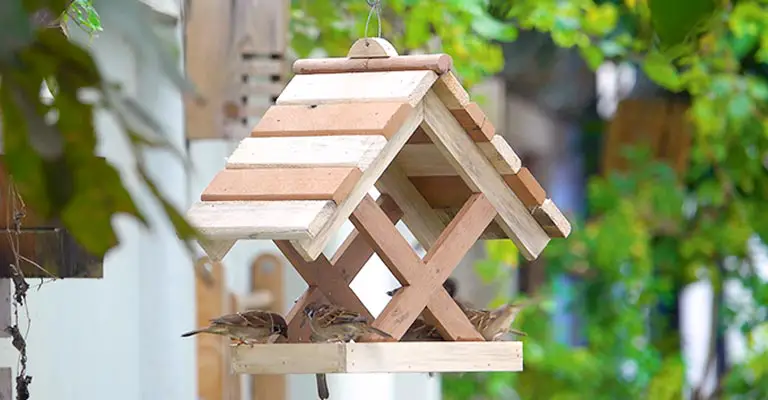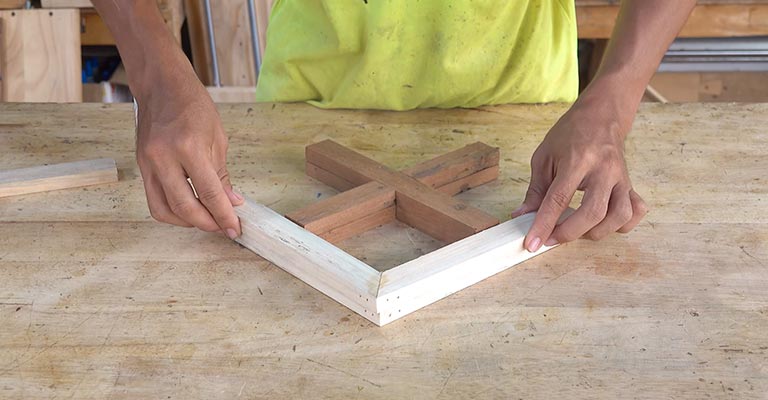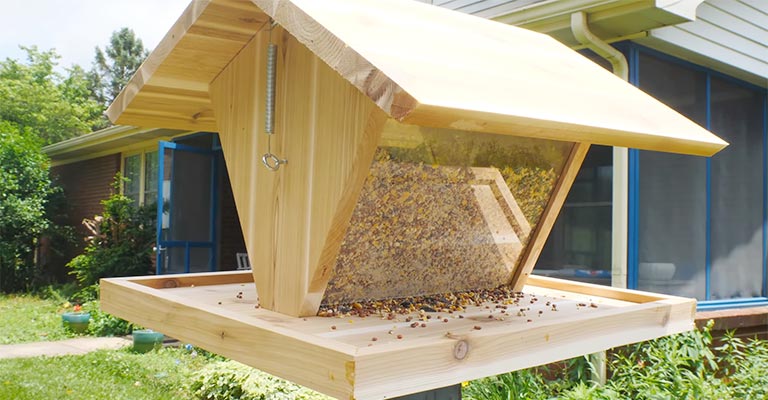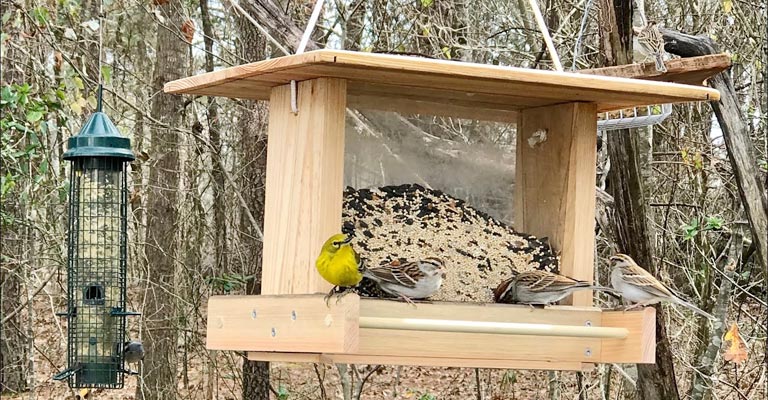Creating a bird feeder out of wood is a delightful and rewarding DIY project that allows you to invite the beauty of nature into your own backyard.
These wooden feeders provide a safe and convenient food source for our feathered friends while also giving us the opportunity to observe and connect with a variety of bird species up close.
Whether you’re an experienced woodworker or just looking for a fun and eco-friendly project, making a bird feeder from wood is an accessible and environmentally conscious way to enhance your outdoor space.
In this guide, we will explore how to make a bird feeder out of wood, from simple tray feeders to more intricate hopper-style or suet feeders. Join us in discovering the joy of attracting and nurturing avian life in your garden.

How To Make A Bird Feeder Out Of Wood?
Here are some simple methods to make a bird feeder out of wood:
Basic Tray Feeder
Start with a flat piece of wood as the base. Attach short wooden dowels on all four sides to create a simple ledge. Birds can easily land on the ledge and access the birdseed. Make sure to add drainage holes to prevent water accumulation.
Hopper Feeder
Craft two wooden rectangles to form a box-like shape, leaving one side open. Add a slanted roof to protect the seeds from rain. Install a dowel or perch near the opening.
Fill the hopper from the top, and as birds perch, more seeds will spill out for them to eat.
Log Feeder
Hollow out a small log, leaving a portion of the wood intact on one side. Drill holes for seeds at different depths and angles inside the hollow section. Hang the log securely, providing birds access to the embedded seeds with their beaks.
Wine Bottle Feeder
Cut a wooden board with appropriate holes to hold a wine bottle securely. Insert a bottle filled with birdseed into the holes. As the seeds are consumed, they will naturally refill the feeding tray below.
Suet Feeder
Create a wooden frame with a grid pattern. Fill the compartments with suet, a high-energy bird food. Hang this feeder securely and watch insect-eating birds, like woodpeckers, enjoy their meal.
Platform Feeder with Roof
Design a flat platform with raised edges to hold seeds. Attach a pitched roof made of wood to shield the seeds from rain. Add a dowel perch at one end. This feeder allows birds to feed comfortably under protection.
Puzzle Feeder
Craft a wooden puzzle with moving parts. Birds must solve the puzzle to access the seeds hidden within. This mentally stimulating feeder provides entertainment for both you and the birds.
Remember to sand down rough edges and use bird-safe, non-toxic finishes if you decide to paint or seal the wood. Additionally, place the feeder in a location where you can enjoy watching the birds while ensuring their safety from predators.
What Are Some Of The Best Woods To Make A Bird Feeder?

Choosing the right type of wood for your bird feeder is crucial, as it ensures the feeder’s durability and the safety of the birds. Here are the types of wood commonly used for making bird feeders, along with their descriptions:
Cedar
Cedar is a popular choice for bird feeders due to its natural resistance to decay, insects, and moisture. Its aromatic oils act as a natural insect repellent, making it an excellent choice for outdoor use.
Cedar is lightweight, making it easy to work with, and its reddish-brown color adds a rustic charm to your feeder.
Redwood
Redwood is another excellent choice for bird feeders, known for its resistance to decay and insects. It has a beautiful reddish hue and can withstand harsh weather conditions. Redwood is durable, making it a long-lasting option for your feathered visitors.
Pine
Pine is readily available and affordable, making it a popular choice for bird feeders. While it is less resistant to decay compared to cedar or redwood, treating pine with a weather-resistant finish can enhance its longevity.
Pine is easy to work with and can be stained or painted to match your outdoor décor.
Hemlock
Hemlock wood is lightweight and relatively inexpensive, making it a practical choice for bird feeders. It is easy to work with and can be treated to improve its resistance to weather and insects.
Hemlock has a pale color and can be stained or painted to achieve the desired look.
Douglas Fir
Douglas fir is a strong and sturdy wood that is commonly used for outdoor applications. It is resistant to decay and can withstand harsh weather conditions.
Douglas fir has a light reddish-brown color and can be sealed or stained to enhance its appearance and protect it from the elements.
Mahogany
Mahogany is a hardwood known for its durability and resistance to decay. It has a rich, reddish-brown color and a smooth texture, making it an attractive choice for bird feeders.
Mahogany requires minimal maintenance and can withstand outdoor exposure for a long time.
Oak
Oak is a dense and durable hardwood that is resistant to decay and insect damage. It is a strong wood, making it suitable for building sturdy and long-lasting bird feeders.
Oak has an appealing grain pattern and can be stained or finished to enhance its natural beauty.
When selecting wood for your bird feeder, ensure it is sourced sustainably and free from harmful chemicals or preservatives. Regular maintenance, such as sealing or staining, will prolong the life of the feeder and keep it looking beautiful for years.
How Do I Know If My Bird Likes Its Feeder?

Understanding whether your birds like their feeder is essential to ensure their well-being and enjoyment. Here are the signs that can help you determine if your feathered visitors appreciate the feeder:
Frequent Visits
If you notice a consistent stream of birds visiting the feeder throughout the day, it’s a positive sign that they enjoy the setup. Frequent visits indicate that they find the food source appealing and reliable.
Minimal Seed Waste
Birds will often scatter or kick out seeds they don’t like. If you observe that there is minimal seed waste on the ground around the feeder, it suggests the birds are consuming most of what you provide.
Varied Species
A diverse range of bird species visiting the feeder is a strong indicator of its popularity. Different species have varied dietary preferences, and a mix of birds suggests your offerings are catering to their needs.
Feeding Behavior
Watch for the birds’ feeding behavior. Content birds will feed calmly and return frequently. Aggressive or dominant behaviors, such as squabbling or chasing others away, may indicate competition for limited resources.
Audible Chatter
Birds often communicate with each other through vocalizations. If you hear cheerful chirping and singing around the feeder, it’s a clear sign that the birds are content and socializing while feeding.
Cleanliness
A well-maintained feeder is more likely to attract birds. Birds appreciate a clean and hygienic environment, so they regularly clean the feeder and the area around it to ensure their comfort.
Regular Nesting
If you notice birds nesting in proximity to the feeder, it’s a strong indicator that they consider the area safe and suitable for rearing their young. Nesting activity is a clear sign of their comfort and preference for your feeder.
It’s essential to pay attention to these signs and adjust your feeding strategy if necessary.
Offering a variety of bird-friendly foods, maintaining a clean environment, and ensuring the feeder is well-stocked are key to attracting and keeping birds happy at your feeder.
Mistakes To Avoid When Making Bird Feeders Out Of Wood

Creating a wooden bird feeder can be a rewarding project, but there are common mistakes to avoid to ensure the feeder is functional and safe for your feathered visitors. Here are some mistakes to be mindful of:
Using Toxic or Treated Wood
Avoid using wood that has been treated with toxic chemicals or finishes. These can be harmful to birds when ingested or in contact with their beaks and feet. Stick to untreated, bird-safe wood types.
Poor Construction
Inadequate construction can lead to a feeder that is unstable, insecure, or prone to falling apart. Ensure the feeder is well-built and sturdy to withstand the elements and bird activity.
Inadequate Drainage
Neglecting proper drainage can lead to water accumulation within the feeder, potentially causing mold or spoiled seed. Include drainage holes to prevent water from collecting.
Inadequate Ventilation
Poor ventilation can result in mold growth or overheating of seeds, rendering them unappealing or unsafe for birds. Ensure the feeder has ventilation holes to keep the contents fresh.
Incorrect Placement
Placing the feeder in a location that’s inaccessible to birds or too close to potential hiding spots for predators can discourage birds from using it. Opt for an open, bird-friendly location.
Using Weak Hardware
Using low-quality or insufficient hardware can lead to the feeder falling apart or being easily breached by squirrels or other pests. Use durable screws, hinges, and hooks for a secure build.
Inadequate Maintenance
Neglecting regular maintenance, such as cleaning and refilling, can lead to the feeder becoming unattractive to birds due to mold, spoiled seed, or dirt. Keep the feeder clean and well-stocked to maintain its appeal.
Avoiding these common mistakes will help you create a bird feeder that not only attracts birds but also provides them with a safe and enjoyable feeding experience.
Taking the time to plan and construct the feeder properly will benefit both you and the feathered visitors in your garden.
FAQs
What are the basic materials I need to make a wooden bird feeder?
To create a simple wooden bird feeder, you’ll need wood boards or planks, screws or nails, a saw, measuring tape, and a drill. You may also want to use sandpaper, wood glue, and paint or sealant for finishing and weatherproofing.
What types of wood are best for building bird feeders?
The best woods for bird feeders are untreated, rot-resistant options like cedar or redwood. These woods are durable, naturally weather-resistant, and safe for birds.
However, you can use other woods, provided they are untreated and safe for outdoor use.
How can I attract specific bird species with my feeder design?
To attract particular bird species, consider their dietary preferences and feeding habits. For example, use larger perches and feeding trays for platform feeders to accommodate cardinals and jays or offer suet feeders to attract woodpeckers and nuthatches.
Are there any safety considerations when building a bird feeder from wood?
Safety is paramount. Avoid using treated or toxic wood, as the chemicals can harm birds. Ensure all components are securely fastened to prevent the feeder from falling apart.
Smooth down sharp edges, and if using paint or sealant, choose bird-safe, non-toxic options.
How can I maintain my wooden bird feeder to ensure it lasts and remains bird-friendly?
Regular maintenance is key. Clean the feeder periodically to prevent mold and spoilage. Refill it as needed, especially in colder months when food may be scarce.
Inspect for damage and repair or replace any worn or rotting parts to keep them attractive and functional for the birds.
Conclusion
Crafting a bird feeder out of wood is not only a creative endeavor but also an act of goodwill towards the avian inhabitants of your local ecosystem.
By providing a reliable food source, you encourage birds to visit regularly, enriching your outdoor experience with their charming presence.
Additionally, observing these winged visitors can promote a deeper connection with nature and a sense of responsibility for bird conservation.
Whether you opt for a straightforward design or a more elaborate one, the satisfaction of seeing birds enjoy your handiwork is a truly fulfilling experience.
So, take up the tools, embrace your creativity, and embark on the journey of creating a wooden bird feeder that will both enhance your outdoor space and contribute to the welfare of your avian neighbors.